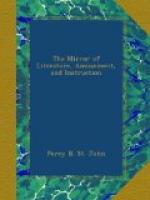We ought to add that the volume is by an inhabitant of Epsom, and the profits of its sale have been given to the Subscription School in the town. It is so inaccurately printed, as to make us hope that more attention will be paid to the typography of the next edition; for assuredly so interesting a volume, published with so laudable an object as that of aiding the cause of charity, should extend to more than one edition.
By the way, there is a nice little anecdote connected with the sign of the Queen’s Head at Epsom,[9] which the editor of this volume would do well to insert in his next impression. The above sign, (the original; for we fear the board has been repainted,) was executed by Harlow, the artist of the celebrated picture of the Trial of Queen Katherine, or the Kemble Family. The painter, it will be remembered, was a pupil of the late Sir Thomas Lawrence. He was a young man of consummate vanity, and having unwarrantably claimed the merit of painting the Newfoundland dog introduced in Lawrence’s portrait of Mrs. Angerstein, the two artists quarrelled, and Harlow took his resentment as follows:
“He repaired to the Queen’s Head at Epsom; where his style of living having incurred a bill which he could not discharge, he proposed, like Morland under similar circumstances, to paint a sign-board in liquidation of his score. This was accepted—he painted both sides: the one presented a front view of her Majesty, in a sort of clever dashing caricature of Sir Thomas’s style; the other represented the back view of the Queen’s person, as if looking into the sign-board; and underneath was painted, ‘T.L., Greek Street, Soho.’ When Sir Thomas met him, he addressed him with, ’I have seen your additional act of perfidy at Epsom; and if you were not a scoundrel, I would kick you from one end of the street to the other.’—’There is some privilege in being a scoundrel, for the street is very long,’ replied Harlow, unabashed, but moving out of reach of the threatened vengeance. Such is the current story; but there must be some error either in the facts or their date. Harlow was but a youth eighteen years old when he left Lawrence, and too young therefore for a man’s resentment; neither had his conduct, a mere tricky slip, been such as to call forth fierce language in a person habitually so cautious and guarded as Lawrence. On the other hand, had Harlow arrived at manhood when it happened, he would not have allowed the words ‘scoundrel’ and ‘perfidy’ to pass with impunity. However all this may have been; the pupil quarrelled with Lawrence, and resolving to be master of his own movements in future, commenced working for himself."[10]
[9] The Queen’s Head
is situated at the extremity of the town of
Epsom, so that a few race-visiters
from London may extend their
journey to that point.
[10] Lives of British Painters. By Allan Cunningham, vol. v.




